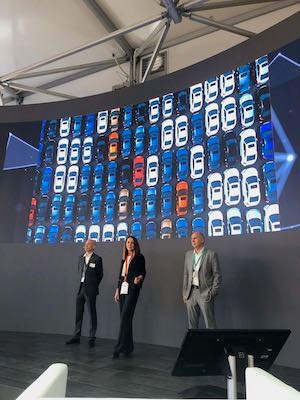No more black and tan trim in next-generation vehicles says partnership between ExxonMobil, Clariant, the Plastivaloire Group.
October 16, 2019

Browsing the parking lot at the K Show in Düsseldorf, Germany, one may find a lot of black or white cars but interspersed among them a fair proportion of vehicles featuring other, more vibrant exterior colors. Look on the inside, however and color appearances can be somewhat bland, with black or tan being most common for plastic interior trim, and any color coming from textile trim.
|
More color options are now available for auto interiors through a three-way collaboration. |
This situation could be about to change, however, with the car of the future having many such interior color options too if a collaboration between polypropylene (PP) supplier ExxonMobil, color masterbatch supplier Clariant Masterbatches, and Plastivaloire Group, a specialist in automobile interior design, goes to plan.
The tie-up has already produced a huge new family of colors that can be expected to change the look of car interiors dramatically in the next few years. The colors are being introduced during a special technical presentation on the ExxonMobil stand (Hall 10 / 10.1) at K 2019, scheduled for October, 17 and 22, at 15:00 and noon, respectively.
Xavier Clément, Regional Sales and Project Manager – Automotive at Clariant, says the idea for the collaboration came during an automotive fair where he met Valérie Martin Maillet, a color expert for performance polyolefins (PP compounds) at ExxonMobil and Aurélie Nangniot, a designer from Plastivaloire. “We each recognized that vehicle design would be changing fundamentally in the coming years,” says Clément. “Especially given the trend toward shared cars or self-driving vehicles, drivers and passengers will want to decorate the interior of their car the same way they decorate their living rooms. We realized that, alone, we could not provide a real solution but, if we collaborate, we would be able to better serve car manufacturers and automotive designers.”
ExxonMobil was already working on a new family of performance polyolefins. With a 10% talc loading and 8% lower density than previous-generation materials, its Exxtral performance polyolefins are lightweight, an important factor in improving fuel economy.
Despite the lower talc loading, these PP grades still retain good impact strength at lower temperature as well as good scratch resistance, according to Anne Villard, Performance Product – Automotive Program Manager at ExxonMobil, who was speaking at the K Show presentation. “They also boast low VOC emissions and recyclability.” The developmental base grade introduced at K for use with color masterbatches is dubbed Exxtral BMU046x and has an MFR of 20. As with other such Exxtral grades, it delivers better flow characteristics and can thus be molded in thinner section, it is non-tacky, and also scratch- and UV-resistant. To be successful in the market, however, these grades also needed to be easy to color for outstanding aesthetics. That’s when the other partners stepped in.
At Plastivaloire, Aurélie Nangniot, was creating a new, exciting spectrum of accent colors that would work in harmony in automotive interiors. She and the experts at Clariant developed a warm color palette based on natural materials like leather, copper, cork or wood, and a cool spectrum was inspired by fashion and interior design. Warm colors provide a human touch in response to the trend toward higher comfort standards in car interiors, while cool colors reflect the higher technology of multiple screens and connected devices that will characterize the autonomous cars of the future. A total of 23 different hues were eventually selected and molded samples were assembled in a presentation box for easy evaluation.
After discussing the colors and textures with the other collaborators, the color experts at Clariant Masterbatches formulated the color concentrates that would make it easy to turn the ExxonMobil materials into the dazzling hues that would capture the imagination of future drivers and passengers. The formulations have to be carefully crafted to ensure the perfect development of the desired color in the polymer without adversely affecting the performance or aesthetic properties of the material.
“The masterbatches allow unlimited creativity for automotive designers and improve the perceived quality of plastic parts in their vehicle interiors” says Clément.
About the Author(s)
You May Also Like





